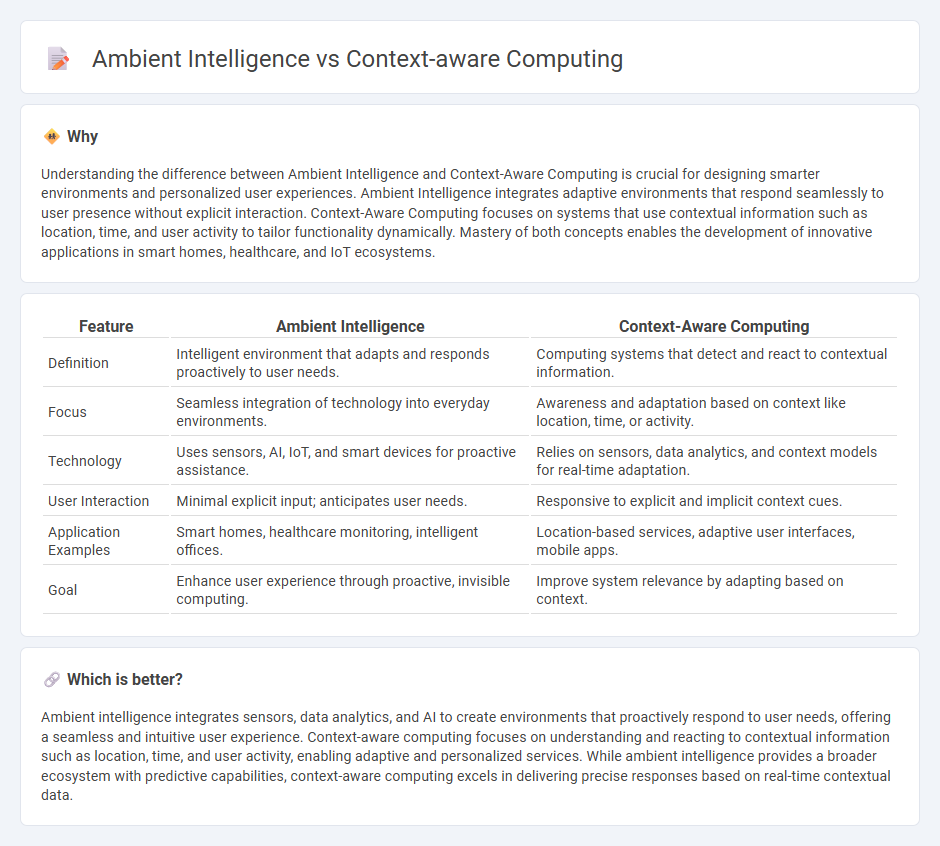
Ambient intelligence integrates sensor-rich environments with adaptive systems to create seamless, intuitive user experiences by anticipating needs without explicit input. Context-aware computing focuses on systems that dynamically adapt their behavior based on real-time contextual information such as location, time, and user activity to provide relevant responses. Explore how these technologies transform interactions and drive smarter environments.
Why it is important
Understanding the difference between Ambient Intelligence and Context-Aware Computing is crucial for designing smarter environments and personalized user experiences. Ambient Intelligence integrates adaptive environments that respond seamlessly to user presence without explicit interaction. Context-Aware Computing focuses on systems that use contextual information such as location, time, and user activity to tailor functionality dynamically. Mastery of both concepts enables the development of innovative applications in smart homes, healthcare, and IoT ecosystems.
Comparison Table
| Feature | Ambient Intelligence | Context-Aware Computing |
|---|---|---|
| Definition | Intelligent environment that adapts and responds proactively to user needs. | Computing systems that detect and react to contextual information. |
| Focus | Seamless integration of technology into everyday environments. | Awareness and adaptation based on context like location, time, or activity. |
| Technology | Uses sensors, AI, IoT, and smart devices for proactive assistance. | Relies on sensors, data analytics, and context models for real-time adaptation. |
| User Interaction | Minimal explicit input; anticipates user needs. | Responsive to explicit and implicit context cues. |
| Application Examples | Smart homes, healthcare monitoring, intelligent offices. | Location-based services, adaptive user interfaces, mobile apps. |
| Goal | Enhance user experience through proactive, invisible computing. | Improve system relevance by adapting based on context. |
Which is better?
Ambient intelligence integrates sensors, data analytics, and AI to create environments that proactively respond to user needs, offering a seamless and intuitive user experience. Context-aware computing focuses on understanding and reacting to contextual information such as location, time, and user activity, enabling adaptive and personalized services. While ambient intelligence provides a broader ecosystem with predictive capabilities, context-aware computing excels in delivering precise responses based on real-time contextual data.
Connection
Ambient intelligence integrates smart environments that respond to users' needs by leveraging context-aware computing, which collects and interprets real-time data such as location, activity, and environmental conditions. Context-aware computing enables devices to adapt their operations autonomously based on dynamic contexts, forming the foundation for ambient intelligence's seamless and personalized user experiences. Together, they drive advancements in smart homes, healthcare monitoring, and adaptive interfaces by enhancing system responsiveness and user interaction efficiency.
Key Terms
Context-awareness
Context-aware computing emphasizes the real-time detection and interpretation of environmental and user-specific data to provide tailored responses, using sensors, machine learning, and adaptive algorithms. Ambient intelligence integrates context-awareness within intelligent environments to seamlessly support users through embedded devices and interconnected systems, enhancing user experience without explicit interaction. Explore more to understand how context-awareness powers adaptive technologies in innovative ambient intelligence applications.
Ubiquitous sensors
Ubiquitous sensors are central to both context-aware computing and ambient intelligence, enabling real-time data collection and environment adaptation. Context-aware computing emphasizes sensor data to tailor system responses based on user context, while ambient intelligence integrates these sensors to create seamless, intelligent environments that proactively support users. Explore further to understand how ubiquitous sensors drive innovation in these interconnected fields.
Intelligent environments
Context-aware computing leverages sensors and data analytics to adapt services and applications based on user context, enhancing interaction efficiency in intelligent environments. Ambient intelligence integrates context-aware technologies with proactive systems that anticipate user needs, creating seamless, adaptive spaces that promote user comfort and productivity. Discover how these innovations are shaping the future of intelligent environments.
Source and External Links
Context Aware Computing - Context Aware Computing enables mobile computers to anticipate user needs by exploiting contextual information such as the user's cognitive and social state, significantly reducing the demand on human attention.
Context-Aware Computing | The Encyclopedia of Human-Computer Interaction - Context-aware computing allows systems to optimize user interfaces and functionality in real-time for multiple contexts of use, improving usability by responding dynamically to the user's situation.
Context-aware pervasive systems - Context-aware computing refers to mobile systems that sense their environment and adapt their behavior according to factors like location, nearby people, devices, and social situation, a concept that originated from ubiquitous computing research in the early 1990s.
 dowidth.com
dowidth.com